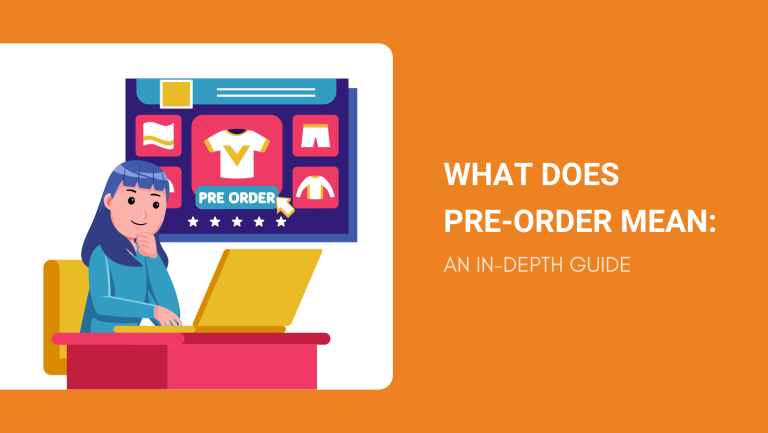As you source goods from different suppliers, you may have come across ‘pre-order’ as one of the buying options on some items.
If you have never pre-ordered before, such offers may leave you with more questions than answers. What does pre-order mean? How does it work for sellers and buyers? Should you offer pre-ordered products in your online store?
Well, wonder no more. Settle in and read on as we take a deep dive into pre-ordering and provide all the answers you have been seeking.
Shall we begin?

What Is a Pre-order?
A pre-order is an order that is placed for an item that is yet to be launched or is sold out and yet to be restocked.
Unlike normal orders, pre-orders can not be processed and fulfilled when you submit them. The supplier can only process the orders once the goods are ready. The timelines are sometimes mentioned in the product listing to let buyers know when to expect availability.
Preorder, Pre-order, or Pre Order?
Grammatically all three spellings have been embraced. However, pre-order and preorder are endorsed by more language authorities.
However, according to Google Trends, people across the globe use ‘pre order’ most in their search terms. It is followed by ‘preorder’ while ‘pre-order’ ranks lowest. This may be worth considering when optimizing your online store for SEO.
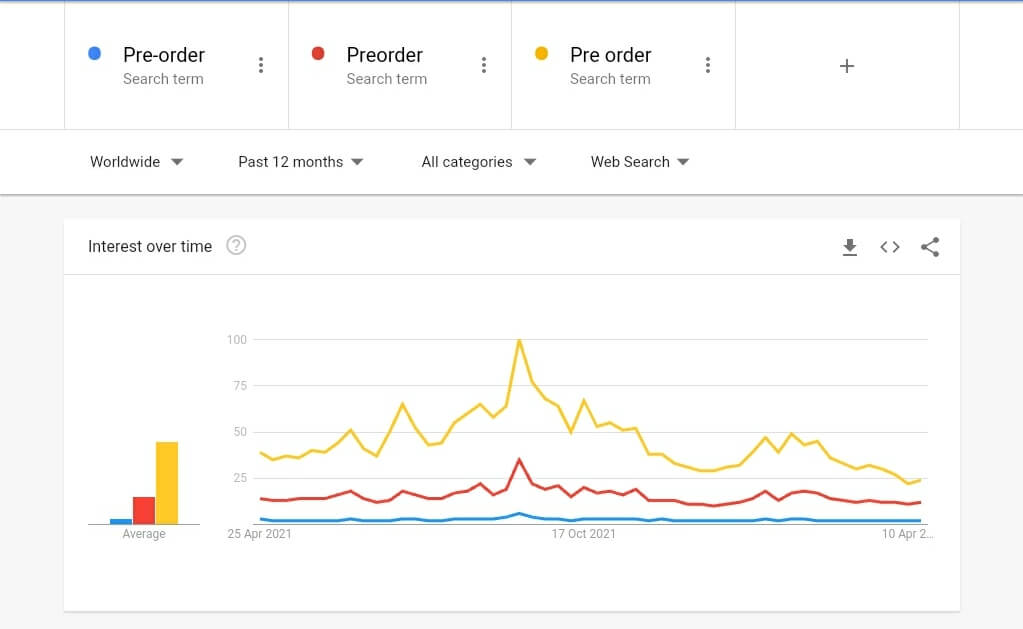
How Does Pre-Order Work?

The pre-order concept comprises multiple stages. Let us discuss each of them for clarity.
Identify the Product(s)
The first step would be to have a solid idea of the goods you plan to offer to buyers on a pre-order basis. It also would not hurt to do some research and find out if they would be willing to pre-order such products.
Partner With a Manufacturer

Aim for an efficient and reliable manufacturer. Keep in mind that pre-orders are pegged on timelines. Customers could be sorely disappointed if you fail to deliver on time due to production delays. So much so that they may even begin to ask for refunds.
That said, while timely delivery is essential, so is product quality. Strive to ensure that your manufacturer can stick to your supply schedule while maintaining high quality standards.
Acquire Samples
Sampling is often not mentioned when it comes to pre-ordering but it is quite important.
If you are launching a new product, samples offer a chance to examine your manufacturer’s quality of work. Beyond that, samples enable you to take photographs for your marketing campaign to entice buyers to pre-order the products.
List the Goods

Listing the goods simply entails having them up on your online store and making it possible for customers to view and pre-order them.
Be sure to also outline the terms of the pre-order purchase. This includes providing details such as:
- When the goods will be ready
- Payment options (whether customers have to pay a deposit or the full price)
- How long the product will be available to pre-order
- Order cancellation policy
Market the Goods
Market the goods to potential buyers as much as you can through ads or even just highlighting them on your e-commerce website.
Email marketing could also be effective, especially if you are marketing a product that you have sold before and would like to inform previous buyers that it will be restocked soon.
Receiving Orders
Customers will likely start to pre-order as they get wind of the products on offer. Carefully keep track of each order so that orders do not overshoot the number of product units you have ordered from your manufacturer.
If the rate of pre-orders is high, consult with your manufacturer to confirm whether they can accommodate such orders. If not, it may be advisable to either close the pre-ordering provision or launch the second batch of pre-orders that will be fulfilled at a later date.
Launch

Once the goods are ready, it would be prudent to notify buyers that pre-ordered. This is particularly relevant if you only asked buyers to pay a deposit and not the full amount.
Notifying them would give them a heads up to prepare the rest of the payments so that their orders are shipped on schedule.
Order Fulfillment
Finally, ensure that every customer that pre-ordered and paid receives their order. Their orders should ideally be prioritized over customers that only ordered once the products were in-stock.
Pay Now vs Pay Later vs Crowdfunding
Sellers can accept payments for pre-orders in 3 main ways:
- Pay now
- Pay Later
- Crowdfunding
Each of these options works differently and may be suitable for different circumstances. Let’s dig a little deeper.
Pay Now

‘Pay Now’ means that customers who pre-order have to pay for their products upfront even though they will receive them much later. It is easy to apply but it is important to consider that laws regarding pre-ordering vary between countries/states.
In most countries, sellers are only legally mandated to disclose to customers that they are buying a product that is not yet available.
However, in some countries, there is more red tape and you would have to meet the requirements or limit buyers in those countries from participating.
Pros
- Sellers can earn revenue upfront and use it to fund manufacturing or necessities such as marketing.
- Buyers can commit upfront and only wait for the shipping day to receive their orders.
- It offers more certainty compared to deferred payments where customers’ circumstances may change and impact their decision or ability to pay.
Cons
- Upfront payments for pre-orders may be complicated by red tape in some jurisdictions.
- Some buyers may have misgivings about paying for a product that they have to wait for. More so if it is the first time they are buying it.
Pay Later
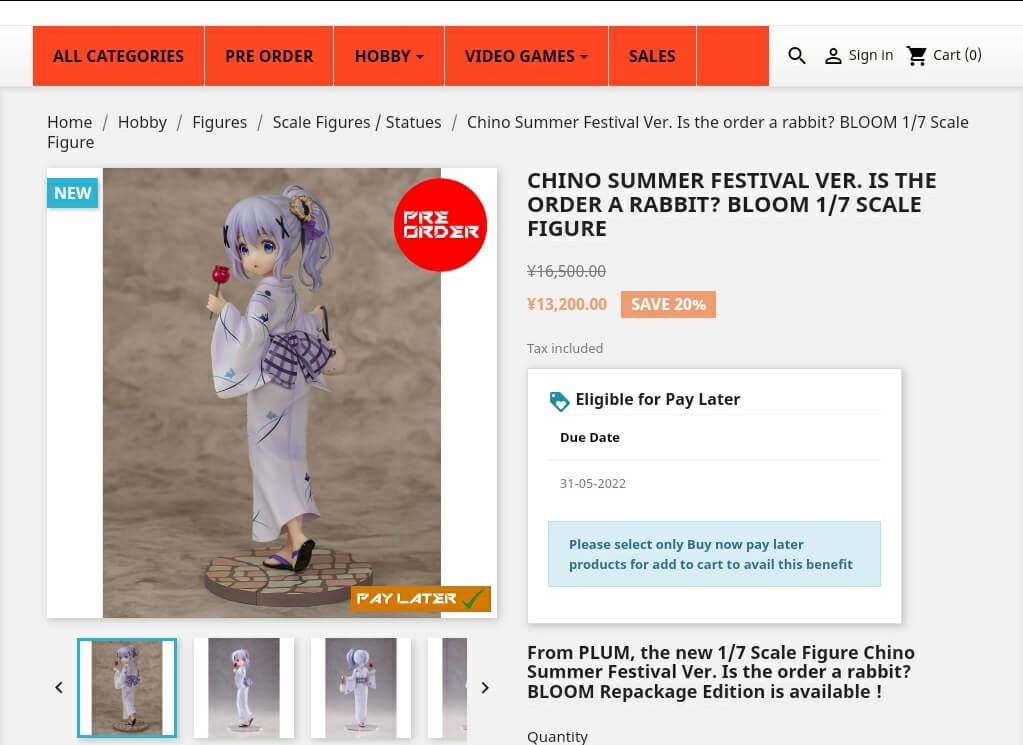
In the ‘Pay Later’ approach, buyers place their orders and they are noted by your online store’s order system. However, they are not required to pay as they place the order.
Instead, you (the seller) would send buyers a link that they can use to pay for their orders later on. You can disclose the payment date or simply provide a link later on. It is, nonetheless, ideal to give buyers a sufficient window to honor their payment.
Pros
- Paying later may be more palatable for skeptical buyers that may be wary about paying upfront.
- Deferred payments give sellers the freedom to decide when to charge buyers. They can charge buyers right before shipping or even midway during production if they are in a capital crunch.
- It is effective in situations where sellers would like to gauge demand before going into production.
Crowdfunding
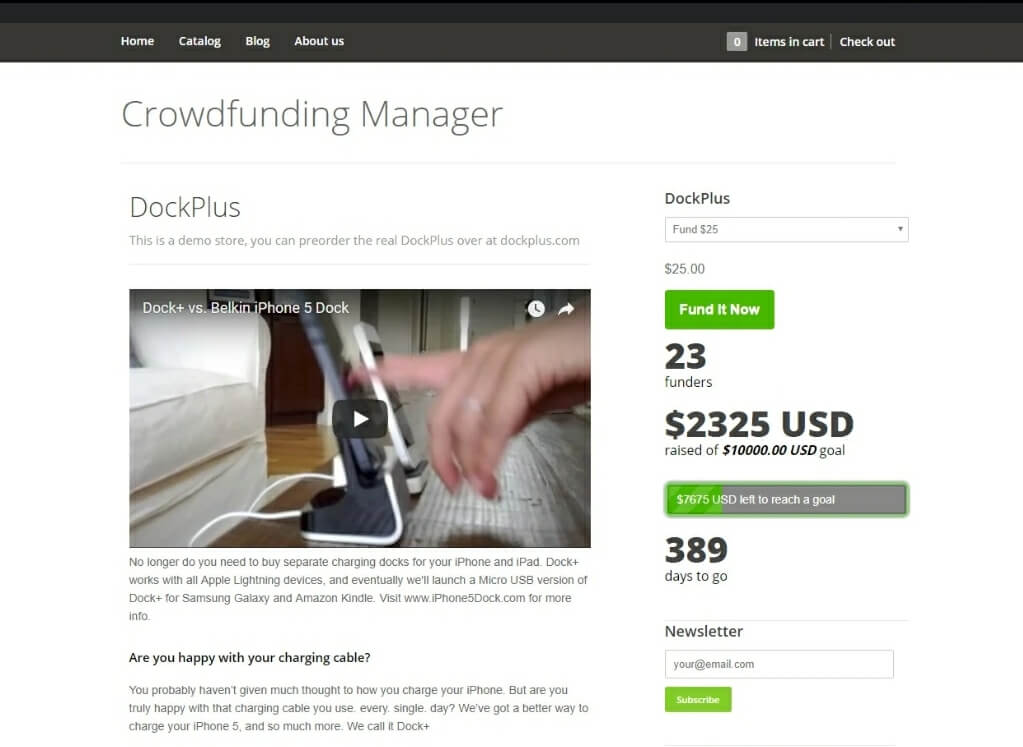
Crowdfunding is an approach where a seller outlines:
- The product that they would like to offer for pre-order purchase.
- How much they need to produce it.
- Timelines or any other terms of the pre-order.
This is usually done on crowdfunding platforms like Indiegogo or Kickstarter. Shopify now also has an app that store owners can use to list such projects on their online stores.
Once the crowdfunding request is listed, buyers and other interested parties pre-order to fund the making of the product.
This type of pre-ordering is usually based on an expectation. Some may pre-order because they want to guarantee that they will get the product once it is manufactured. Others may do it because:
- They are interested in the project and would like to see its outcome. Somewhat like an angel investor would.
- They would like equity or some other exclusive reward once the product is launched.
Pros
- Crowdfunding offers more wiggle room in terms of time. Funders are usually more accepting of longer waiting times than typical buyers.
- Crowdfunding provides upfront revenue for sellers to fund manufacturing and other pertinent processes.
- Some crowdfunding platforms provide additional support by marketing your project on your behalf.
Cons
- Not all products may do well on crowdfunding pre-orders. It tends to favor unique innovative ideas.
- Most crowdfunding sites take a percentage commission of the funds you receive.
- Crowdfunding requires lots of effort because you need to market and drive traffic to your project to get funding.
- Unlike typical pre-orders, crowdfunding needs you to show and prove in detail why your product is worth funding.
When and Why Would You Offer Pre-Orders?
Implementing pre-ordering correctly ensures that you reap maximum gains from it. Now that we know the basics of how it works, let’s discuss how to apply it.
Gauging Consumer Interest

Introducing a product into any market comes with a lot of uncertainty. Will consumers like it? Will they buy it? Will you be able to make a profit?
On top of that, production is a great financial risk. If you invest in manufacturing a product and it ends up not doing well in the market, the losses can be crippling.
Fortunately, pre-ordering can help you gauge consumer interest before you begin mass production. If lots of customers pre-order after learning of the product, you can begin production. If not, you can reconsider your options without suffering any major losses.
Improving Supply Logistics
Real-time orders can be overwhelming for a business. More so if the demand for a product is high or you serve a vast market.
Pre-orders offer some reprieve from this pressure. They allow you to organize your supply chain logistics based on the orders that you receive. In turn, you will have an easier time fulfilling orders when the time comes.
Providing Certainty to Buyers

Some items generate an extremely high level of interest among buyers. This often creates a shortage and lots of anxiety. In such instances, allowing your customers to pre-order would be ideal because it assures them that they will get what they need.
The trick, however, is to only allow pre-orders equivalent to the number of product units that will be available. Customers can be quite unforgiving if they buzz with high anticipation and you fail to deliver.
Customer Retention
Take, for illustration, that you sell wholesale hoodies.
Customer A regularly buys hoodies from your store and resells them. If Customer A repeatedly finds the hoodies out of stock, they may have no choice but to consider buying from a different supplier. This is mostly because they have no idea when you will restock.
So, how do you avoid losing such customers to your competitors? Simple, allow customers to pre-order. It reassures them that while there may be a hold-up in the supply, they can still get the same great products they are used to if they wait a short while.
Drumming Up Interest
Limited pre-orders coupled with great marketing could generate significant interest in a product. This is because it creates an aura of scarcity and exclusivity among buyers.
Many would, therefore, leap at the chance to order in advance and secure their position among the chosen few.
Sourcing Capital

Manufacturing and launching any product requires a substantial amount of capital. If you are short on funds, allowing customers to pre-order and pay for a product could earn you enough money to get things on track.
Nevertheless, it is crucial to consider that some buyers may opt out and seek a refund before you launch the product. It is advisable to have contingency funds so that you can settle such matters when they arise.
How to Run a Successful Pre-Order Campaign
The more people know about your pre-order offer, the better it is likely to perform. As such, you will need to run a well-planned and spirited campaign to draw traffic and get as many orders as you can.
Which brings us to the question: how do you pull off a successful pre-order campaign?
Here are some tips to help you ace it.
Plan

Before you start, figure out:
- Your goals – what would you like to achieve through pre-ordering? For instance, if you are raising capital, how much is enough? How many pre-orders can you accept? How long can you accept pre-orders?
- Timelines – consider how long you would like to accept pre-orders and when you would be able to fulfill the orders. Make an effort to also set timelines for when ads will run and when customers should complete payments.
Use these two key factors to create a general strategy. This includes ads, ideal platforms for your ads, and the customers you need to target.
Time Your Campaign for Maximum Gain
Some pre-order campaigns do much better if they are timed correctly.
For instance, if you plan to sell a newly launched device, it is advisable to schedule pre-orders shortly before or during the launch. If you wait too long, customers may not see the need to pre-order. Especially if the device is available elsewhere.
On the flip side, if you are launching a new product then you could time your campaign based on your supply chain. The fourth quarter of the year is also ideal for starting a pre-order campaign if your product is gift-worthy and can be marketed as such.
Create Enticing Ads and Listings
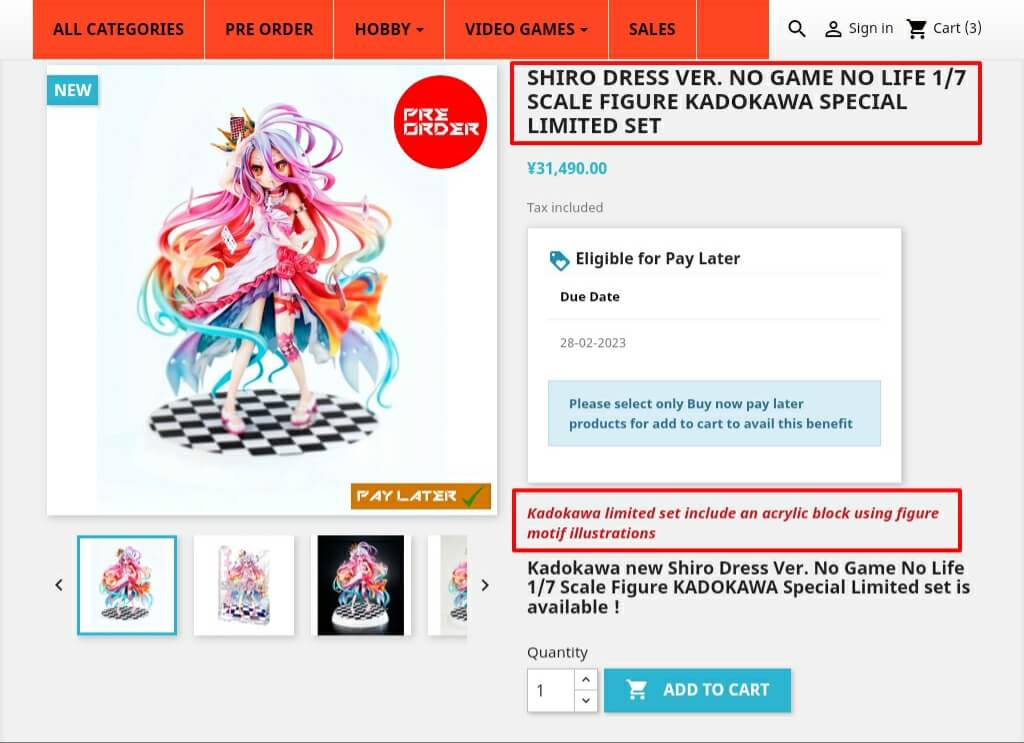
As you prepare ads and product listings for your pre-order campaign, emphasize exclusivity and value.
Exclusivity here means customers will get first access to the product once it is launched. Be sure to also inform them if the product or a particular design will only be available for a limited run.
Value, on the other hand, comprises any other gains buyers may enjoy if they pre-order. This could include a slightly discounted price, discounted shipping, special packaging, or priority shipping.
The goal here is to entice buyers by making pre-order offers feel irresistible and worth their while. If your budget allows, you could also work with influencers to drum up even more interest and FOMO among buyers.
Roll Out Strategic Ads
Advertising is crucial when it comes to getting the word out to potential buyers. However, the more strategic your ads, the more effective they will be. Strive to:
- Identify your target market – if you are launching a new product, cast a wide net and target demographics that would typically consume your product. If you are restocking, target new customers but also remarket to your usual buyers.
- Use the right advertising platforms – email marketing is ideal for remarketing. For new customers, consider ad platforms like Facebook Ads or Google Ads that allow you to market based on the demographics of your target market.
Do not overlook the importance of highlighting pre-orders on your online store either. Homepage banners, for example, could easily attract the attention of anyone that visits your website. It’s too much user traffic to ignore.
Prepare for Traffic
As you put in the effort to drive traffic to your store, do not forget to prepare for it. A surge in traffic could easily overwhelm your site and cause it to crash. So, ensure that you have enough bandwidth to handle an influx of site guests and adequate security features.
Pros and Cons of Pre-Orders

Pros
- Pre-orders make it possible to test how a product will perform in the market without suffering major losses.
- Sellers can boost their capital using revenues earned from pre-orders.
- Pre-orders help sellers avoid dead stock because they can limit production to a more accurate number of units.
- Pre-orders work as an effective way to create buzz around a product before it even hits the market.
Cons
- Not all customers are open to pre-orders. More so if they have to pay upfront and the purchase involves a substantial amount of money.
- Pre-orders are not always a done deal. Customers can always pull out before you can fulfill their orders.
- Manufacturing delays or other supply chain mishaps can stir impatience among buyers and even lead to an avalanche of canceled orders.
- Not all e-commerce platforms support pre-orders.
FAQs about Pre-orders
How Long Should Pre-Orders Take?
There is no defined period of how long pre-orders should take. Timelines may vary based on factors such as:
- How long it typically takes to manufacture specific products.
- Where the production is being done and how long it takes to ship orders from there.
- The scale of the orders; wholesale orders are likely to take a bit longer than retail orders.
That said, the shorter the turnaround time, the better. Aim for durations between 2 to 8 weeks. Long wait times can make buyers impatient and make it more practical for them to buy from other suppliers, if possible.
Do Pre-Orders Arrive Earlier?
Most sellers prioritize shipping pre-orders when the products are ready for delivery. Therefore, you may receive your order earlier than buyers who ordered on the release date.
Do Pre-Orders Cost More?
Not ordinarily. In fact, on the contrary, pre-orders usually come with discounts to entice buyers.
However, in some cases, the pre-order price may be higher than the item’s average price a month or so after the launch.
This is because, before a launch, highly sought-after products are scarce and in high demand. Naturally, this drives up prices. Later, as demand normalizes and supply increases, prices become lower.
In a nutshell, high pre-order prices are mostly drivenby supply and demand.
Is It Possible to Cancel Pre-Orders?
Yes, it is.
The only catch is that order cancellation policies may vary between sellers. Always make an effort to read through such policies before you commit to pre-orders so that you know what your options are from the start.
It is also worth mentioning that cancellation can go both ways. Even a seller can choose to cancel pre-orders due to issues such as:
- Unforeseen or unavoidable circumstances like a pandemic.
- A lack of sufficient orders.
- The proposed product not being viable.
In such a case, the seller is also bound to the terms and conditions of the order cancellation policy.
Which Is the Best Pre-Order Method?
It all depends on your goals and your target market.
For example, if you would like to source capital and begin production without too much pressure from buyers, crowdfunding would be ideal.
On the other hand, if you are using pre-orders for customer retention between supply runs, then the pay now or pay later methods may come in handy. It all depends on the level of trust between the buyer and the seller.
Suffice to say, it is best to analyze each situation uniquely and then pick the right solution for it.
Final Word
In today’s world, most consumers have a fear of missing out and constantly want to be on-trend. The marketing concept of pre-order, therefore, is very appealing because of the exclusivity it contains. Consequently, it is fair to say that pre-orders are a win-win for all.
Would you like to start offering pre-orders in your store? We can help you source products or find reliable manufacturers to partner with. We are also well-experienced in timely order fulfillment and can organize worldwide shipping of goods.
To get started, send us a brief of your sourcing requirements and request a free quote at any time.
